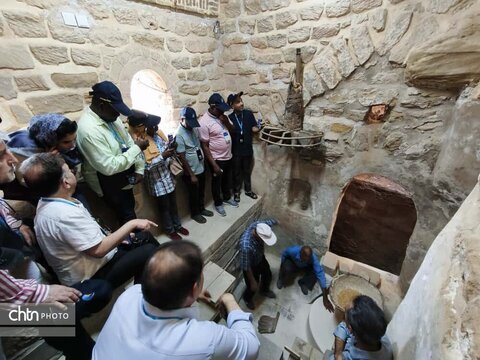UNESCO representatives visit Shushtar Historical Hydraulic System

TEHRAN—A delegation comprising the representatives of UNESCO organization from Algerian, Tanzania, Nigeria, and Iraq visited Shushtar Historical Hydraulic System in Khuzestan province.
According to Miras-e Arya (CHTN), the delegation visited this southwestern province in line of holding a training workshop hosted by the Energy Ministry.
They were accompanied by the experts of Shushtar Historical Hydraulic System base and representatives of Khuzestan Water and Electricity Department.
They visited the important and essential parts of this valuable complex, including the Gargar River, Mizan Dam (Band-e Mizan), the mill area, and the waterfalls.
During this visit, the experts provided comprehensive and specialized explanations, explaining Shushtar's unique water system and how the mills functioned to the delegates.
The mill's operation was then demonstrated in the field to fully introduce the technical and cultural dimensions of this outstanding global work.
The Shushtar Historical Hydraulic System World Heritage Site, while expressing its satisfaction with the presence of this international delegation, emphasized its commitment to preserving, restoring, and introducing this precious heritage and announced its readiness for further cooperation with international institutions in order to protect the world heritage of the ancient land of Shushtar.
The ancient hydraulic system comprises bridges, weirs, tunnels, canals, and a series of ancient watermills powered by human-made waterfalls. It is named after an ancient city of the same name with its history dating back to the time of Darius, the Great, the Achaemenid king.
The property is as rich in its diversity of civil engineering structures and constructions as in the diversity of its uses (urban water supply, mills, irrigation, river transport, and defensive system). The Shushtar Historical Hydraulic System testifies to the heritage and the synthesis of earlier Elamite and Mesopotamian know-how; it was probably influenced by the Petra dam and tunnel and by Roman civil engineering.
The hydraulic system has been considered a Wonder of the World not only by the Persians but also by the Arab-Muslims at the peak of their civilization.
Furthermore, one of its main canals is a veritable artificial watercourse that made possible the construction of a new town and the irrigation of a vast plain, at the time semi-desert.
UNESCO says that the Shushtar Historical Hydraulic System demonstrates outstanding universal value as in its present form, it dates from the 3rd century CE, probably on older bases from the 5th century BC. It is complete, with numerous functions, and large-scale, making it exceptional.
KD
Leave a Comment